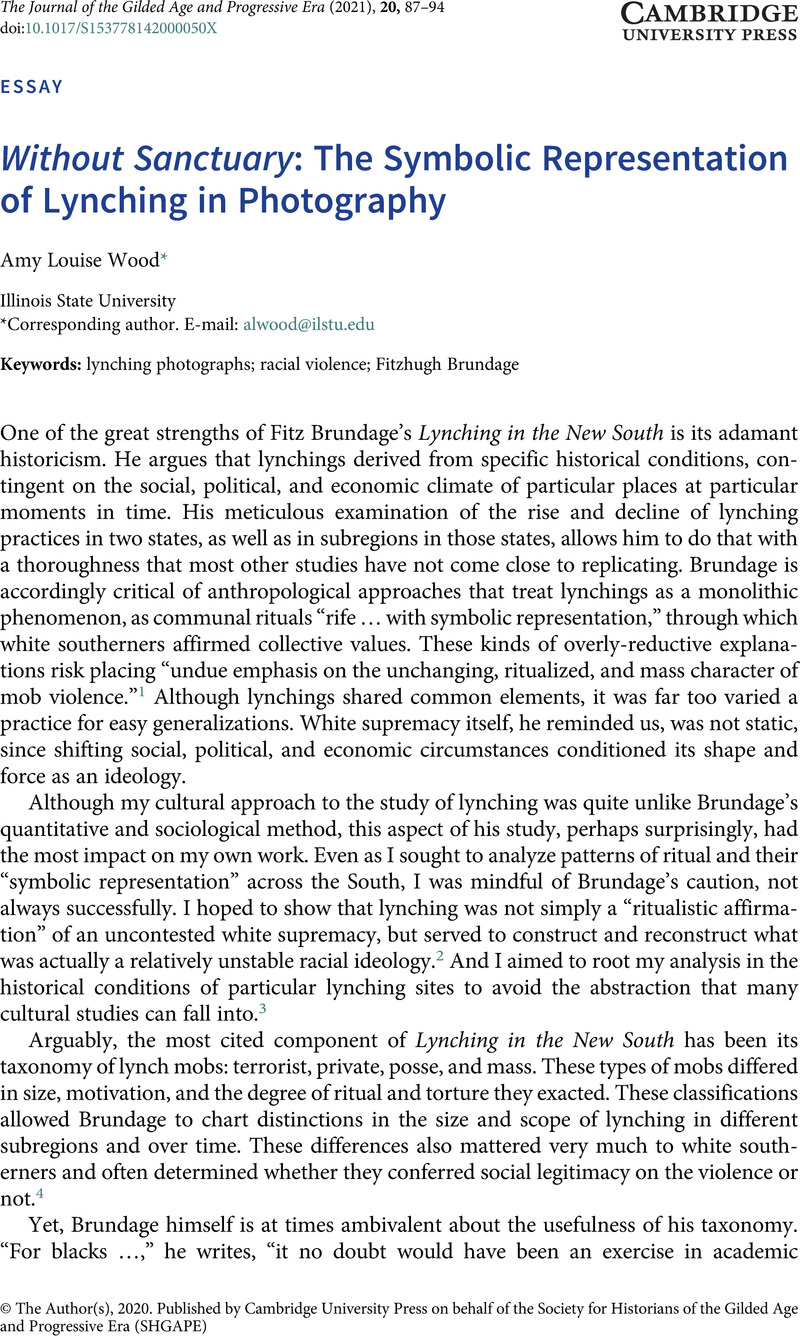No CrossRef data available.
Article contents
Without Sanctuary: The Symbolic Representation of Lynching in Photography
Published online by Cambridge University Press: 01 December 2020
Abstract

Information
- Type
- Special Forum: Lynching in the New South A Quarter of a Century Later
- Information
- The Journal of the Gilded Age and Progressive Era , Volume 20 , Issue 1 , January 2021 , pp. 87 - 94
- Copyright
- © The Author(s), 2020. Published by Cambridge University Press on behalf of the Society for Historians of the Gilded Age and Progressive Era (SHGAPE)
References
Notes
1 Brundage, W. Fitzhugh, Lynching in the New South: Georgia and Virginia, 1880–1930 (Urbana: University of Illinois Press, 1993), 17 Google Scholar.
2 Brundage, Lynching in the New South, 19.
3 Wood, Amy Louise, Lynching and Spectacle: Witnessing Racial Violence in America, 1890–1940 (Chapel Hill: University of North Carolina Press, 2009)CrossRefGoogle Scholar.
4 Brundage, Lynching in the New South, 26–28, 31–32.
5 Brundage, Lynching in the New South, 45.
6 Brundage, Lynching in the New South, 45–46.
7 Brundage, Lynching in the New South, 34.
8 Brundage, Lynching in the New South, 18.
9 Wood, Lynching and Spectacle, 77.
10 See Allen, James, Without Sanctuary: Lynching Photography in America (Santa Fe, NM: Twin Palm Publishers, 2000)Google Scholar, plates 86 and 87; New York Times, Feb. 12, 1906, 4; Chicago Tribune, Feb. 12, 1906, 5.
11 Allen, Without Sanctuary, plate 15.
12 Allen, Without Sanctuary, 203–204; Richard Lacayo, “Blood at the Root,” Time (Apr. 10, 2000): 122–23.
13 Brundage, Lynching in the New South, 252.
14 Leon Litwack, “Hellhounds” in Without Sanctuary, plate 11.
15 Robert E. Snyder, “Without Sanctuary: An American Holocaust?,” Southern Quarterly 39:3 (Spring 2001): 162; Dora Apel, “On Looking: Lynching Photographs and the Legacies of Lynching after 9/11,” American Quarterly 55 (2003): 459–60.
16 www.withoutsanctuary.org (accessed Dec. 28, 2018).
17 New York Times, June 14, 2005, A15; Senate Resolution 39, 109 Cong. (2005), https://www.congress.gov/bill/109th-congress/senate-resolution/39/text (accessed Dec 28, 2018).
18 Brundage, W. Fitzhugh, The Southern Past: A Clash of Race and Memory (Cambridge, MA: Harvard University Press, 2005), 4 CrossRefGoogle Scholar.
19 Sontag, Susan, On Photography (New York: Anchor Books, 1977), 4–5 Google Scholar; Barthes, Roland, Camera Lucida: Reflections on Photography (New York: Hill and Wang, 1981), 76–80 Google Scholar; Zelizer, Barbie, Remembering to Forget: Holocaust Memory Through the Camera’s Eye (Chicago: University of Chicago Press, 1998), 8–10 Google Scholar.
20 John Lewis, “Forward” in Without Sanctuary, 7.
21 Hilton Als, “GWTW” in Without Sanctuary, 38.
22 Hilton Als, “GWTW” in Without Sanctuary, 39.
23 With the exception of several photographs of white lynching victims, of various ethnicities, the vast majority of images in Without Sanctuary depict African American victims and white mobs. Public commentary on the book and the exhibitions have thus focused on Black and white viewers’ responses.
24 “Emory Asks Public to Help Decide Fate of Controversial Exhibit,” Creative Loafing (Atlanta, GA), Dec. 9, 2000, 41.
25 Quoted in Apel, “On Looking,” 465.
26 Als, “GWTW” in Without Sanctuary, 43.
27 Als, “GWTW” in Without Sanctuary, 39.
28 Als, “GWTW” in Without Sanctuary, 40.
29 Dyson quoted in Apel, “On Looking,” 464.
30 Hale, Grace, “Exhibition Review”, Journal of American History 89:3 (2002)Google Scholar, 993-94; JoAnn Wypijewski, “Executioners’ Songs,” The Nation, Mar. 27, 2000, 30, 34.
31 For an overview of this point of view, see Apel, “On Looking,” 464–66.
32 Litwack, “Hellhounds” 10, 14.
33 Litwack, “Hellhounds,” 18.
34 Litwack, “Hellhounds,” 18.
35 Litwack, “Hellhounds,” 34.
36 Sontag, Susan, Regarding the Pain of Others (New York: Picador, 2003), 92 Google Scholar.
37 Patricia Williams, “Without Sanctuary,” The Nation, Feb. 14, 2000, 9.
38 Apel, Dora, Imagery of Lynching: Black Men, White Women, and the Mob (New Brunswick, NJ: Rutgers University Press, 2004)Google Scholar; Apel, Dora and Smith, Shawn Michelle, Lynching Photography (Berkeley: University of California Press, 2007)Google Scholar; Raiford, Leigh, Imprisoned in a Luminous Glare: Photography and the African American Freedom Struggle (Chapel Hill: University of North Carolina Press, 2011)Google Scholar; Baker, Courtney, Humane Insight: Looking at Images of African American Suffering and Death (Urbana: University of Illinois Press, 2015)CrossRefGoogle Scholar.
39 Brundage, Lynching in the New South, 258–59.
40 Montgomery Advertiser, Aug. 2, 2018 https://www.montgomeryadvertiser.com/story/news/2018/08/02/100-000-people-visit-eji-lynching-memorial-montgomery/879716002/ (accessed Dec. 30, 2018).
41 Montgomery Advertiser, Apr. 25, 2018, https://www.montgomeryadvertiser.com/story/news/2018/04/25/without-sanctuary-and-how-we-remember-lynching/499641002/ (accessed Dec 30, 2018); on this point, see also Jason Morgan Ward, Museum Review, “The Legacy Museum: From Enslavement to Mass Incarceration; The National Memorial for Peace and Justice,” American Historical Review 123:4 (Oct. 2018): 1272.

